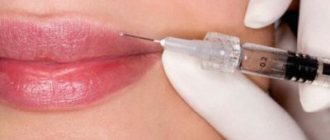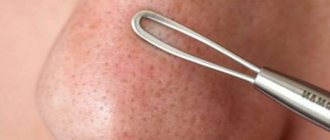Blepharoplasty is a plastic surgery that allows you to correct the shape of the eyes, remove drooping eyelids and bags under the eyes. Many women resort to such surgical intervention; the procedure is quite simple, easily tolerated, but requires effective pain relief. Anesthesia for blepharoplasty can be general or local; what type of anesthesia will be used depends not only on the patient’s personal preferences, but also on the volume of the operation, associated disorders, tolerance of painkillers and a number of other conditions.
Types of anesthesia used for blepharoplasty
Blepharoplasty involves removing fat deposits and tightening muscles through incisions in the skin. Naturally, such manipulation is accompanied by severe pain, so it is impossible without high-quality pain relief. Blepharoplasty can be performed under local or general anesthesia:
- Local anesthesia is local anesthesia of the skin and subcutaneous fat in the affected area. That is, the introduction of a local anesthetic temporarily disables pain receptors specifically in the eye area, and allows operations to be performed without general anesthesia;
- General anesthesia. This term refers to the intravenous or inhalational administration of anesthetics, leading to inhibition of the central nervous system, as a result of which pain sensitivity disappears, muscles relax, reflex reactions are suppressed and consciousness is turned off. The use of modern drugs allows you to select a dose that has minimal negative effects on the body and its effect lasts exactly as long as necessary for the operation.
What to choose - general or local anesthesia
What anesthesia is required for blepharoplasty? It is better to choose the type of anesthesia together with your doctor. Most patients prefer local anesthesia, but you need to know that such anesthesia is only possible if the correction concerns only the lower or upper eyelid. With such an intervention, the volume of the operation is insignificant and not particularly complex in terms of technique, so local anesthesia will allow the plastic surgery to be carried out efficiently.
Most doctors even prefer to combine local anesthesia with sedation, since this puts the patient into a shallow sleep, therefore relaxes and does not interfere with the doctor’s eyelid surgery.
General anesthesia is definitely used if circular blepharoplasty is necessary - simultaneous correction of the lower and upper eyelids, changing the shape of the eyes. Such an intervention requires more time and full concentration of the surgeon, and the effect of local anesthesia to comply with these conditions is insufficient. When choosing an anesthesia option for blepharoplasty, not only the type of correction is taken into account, but also a number of other conditions:
- Patient's age;
- Psycho-emotional status. For people with a high level of anxiety, neuroses, suspiciousness and doubts, general anesthesia is recommended, since with local anesthesia there is a high probability that they will constantly distract the surgeon, which will not have the best effect on the quality of blepharoplasty;
- Tolerance of local anesthetics. A number of patients are allergic to drugs from this group, so they are indicated for general anesthesia;
- Diagnostic data. Before blepharoplasty, an extensive examination is required; it is also necessary to identify indications and contraindications for anesthesia.
Any anesthesia requires preparation of the patient, so the type of anesthesia is selected in advance.
How to choose the right clinic and plastic surgeon?
Before blepharoplasty, you not only need to undergo an examination, but also choose a place for the operation and a doctor. It is necessary to rely on the following points:
- doctor's qualifications;
- practical experience of a doctor;
- elegant results.
A qualified and experienced surgeon always has a good portfolio so that the client can compare photos before and after the operation, which should be on the official website of the clinic. It is on the basis of photographs that the client can draw a conclusion about the quality of the operation performed, as well as whether the doctor uses an individual approach to each of his patients.
We recommend: What anesthesia is used for blepharoplasty?
If the doctor has a video portfolio, then ask to show it at a personal consultation: this is the only way to learn about the surgeon’s qualifications, caution and meticulousness in relation to his work.
Preparatory stage
Preparing a patient for blepharoplasty involves conducting a number of examinations, these are:
- Blood test, including blood clotting, sugar, infections;
- Fluorography;
- ECG – electrocardiogram of the heart.
Consultation with an ophthalmologist and anesthesiologist is required. If general anesthesia is necessary, permission from a physician or cardiologist will be required. For the operation itself to be successful and for no negative consequences to arise, the following is required:
- At least 3 weeks before surgery, stop smoking, drinking alcohol and using blood thinners;
- Compliance with diet therapy on the eve of blepharoplasty. The day before surgery, preference should be given to easily digestible foods; in the morning before surgery, you should not eat or drink.
The patient should be warned in advance about the type of anesthesia chosen, the characteristics of its effect on the body and the condition after the operation.
Preparation for the procedure
Before undergoing blepharoplasty, you need to prepare to minimize risks. It is necessary to undergo examination by specialists, take tests, and avoid taking certain medications and products.
Doctors' recommendations
At the preliminary consultation, the surgeon collects the patient's medical history . Learn about allergies, chronic diseases, and vision problems. The doctor assesses the degree of age-related changes in the eye area, determines the volume and type of blepharoplasty, and determines anesthesia.
Medical examinations and list of tests
Laboratory tests and examinations are necessary to assess the patient's general health.
What tests need to be taken before surgery? Here is their list:
- Clinical blood test. Shows the presence of inflammatory processes and determines the level of hemoglobin.
- Clinical urine analysis. Shows the condition of the kidneys.
- Coagulogram. Examines blood clotting to exclude blood loss.
- Blood type and Rh factor.
- The presence of antibodies to the causative agent of syphilis.
- Blood for HIV infection, viral hepatitis B and C.
also necessary to do an ECG, fluorography, and consult a therapist . Additionally, consultations with specialized specialists and biochemical tests may be prescribed.
Prohibitions
Compliance with a number of prohibitions will prepare the body for surgical intervention. Two weeks before surgery, you need to give up alcohol and smoking. Citrus fruits and chocolate are excluded from the diet for 10 days. The day before, coffee, fatty spicy foods, and smoked foods are prohibited.
Nonsteroidal anti-inflammatory drugs reduce blood clotting. It is recommended to abandon them at least two weeks before plastic surgery.
Features of local anesthesia for blepharoplasty
Pain sensitivity during local anesthesia is turned off in two ways:
- Application - cream is applied to the desired area of the body or gel with anesthetics is sprayed;
- Injection - the anesthetic is injected under the skin using a syringe with a needle.
Blepharoplasty under local anesthesia is performed after injection of drugs. The application method is not used for this type of plastic surgery, since external agents do not penetrate deeply and therefore do not affect the subcutaneous fat. In most cases, injection anesthesia is performed with drugs containing ultracaine, lidocaine, and buvicaine.
Planning the operation
If everything is fine with the tests, then preparations for blepharoplasty take place. The surgeon evaluates the patient’s appearance, analyzes the shape of the eyes and eyebrows, the condition of the muscles, the amount of excess skin and fatty tissue, identifies the severity of facial wrinkles and tells the patient what results can be obtained using a particular blepharoplasty technique.
He should talk about all the methods, their advantages and disadvantages. But, taking into account the patient’s age, his wishes, the condition of the tissues, individual structural features, and budget, the surgeon must recommend the most suitable method. After this, he explains how the operation and rehabilitation period will proceed, and what complications may arise.
It is imperative to clarify all financial issues before surgery, so that there are no questions or disagreements later. To track all changes in appearance, the surgeon takes photographs of the patient from different angles. Many clinics offer computer modeling. Thus, you can see your appearance as close as possible to the result of the operation.
We recommend: How is blepharoplasty performed for wrinkles under the eyes?
Advantages and disadvantages
Blepharoplasty under local anesthesia is preferable to general anesthesia. The main advantages of such pain relief are:
- Slight risk of developing systemic severe complications, possible due to the toxic effects of drugs used during general anesthesia;
- Ability to follow physician orders. During the operation, the surgeon may ask the patient to periodically close and open his eyes, which has a positive effect on the results of the correction;
- Short rehabilitation period after anesthesia. The patient can be under the supervision of clinic staff for only 2-3 hours, and then he is sent home.
Despite the obvious advantages of local anesthesia for blepharoplasty, this type of anesthesia is not always used. Its disadvantages are:
- Possible increase in blood pressure. During plastic surgery on the eyes, most patients are nervous, which often leads to increased blood pressure. This condition does not threaten health, but increases the risk of bleeding, which complicates the surgeon’s work;
- Risk of allergic reactions to the anesthetic used;
- Inability to use local anesthesia for extensive surgery. Most often, local anesthesia is prescribed for upper eyelid blepharoplasty. When correcting a defect in the lower part, the incision is made from the inside and this is not always possible if the operated person is conscious.
Important
If you do not have acute or chronic ophthalmological diseases and during consultation with an ophthalmologist he gave the go-ahead, you can go to the clinic for a consultation on blepharoplasty.
Blepharoplasty under general anesthesia is the best option for most patients and surgeons. A peacefully sleeping patient does not distract or disturb the doctor, and, accordingly, the operation goes faster for both one and the other.
Perhaps another advantage of general anesthesia for blepharoplasty is that the patient will sleep, but with any other anesthesia he will see everything. Many people are afraid of general anesthesia because of its consequences, or rather, not everyone knows that now anesthesia used for general anesthesia is well tolerated and does not cause such consequences as hallucinations, nausea and other unpleasant phenomena.
Blepharoplasty under general anesthesia
General anesthesia can be intravenous or inhalational. When performing blepharoplasty, preference is increasingly given to TIVA anesthesia - a modern method of turning off consciousness. The abbreviation TIVA stands for total intravenous anesthesia, which uses only a mixture of drugs injected into a vein. Inhaled drugs to inhibit central nervous system are not used with this type of anesthesia. The main advantages of TIVA anesthesia:
- There is a slight likelihood of nausea and vomiting after anesthesia;
- Hemodynamic stability of the patient;
- Lowest risk of toxicity for the patient;
- Reduced pressure inside blood vessels;
- Fast recovery period after surgery.
TIVA anesthesia provides automatic administration of a pre-calculated dose of anesthetics and continuous monitoring of the patient's condition. Total intravenous anesthesia can also be used if the patient has a persistent form of arterial hypertension.
General anesthesia, unlike local anesthesia, ensures complete relaxation of the muscles and switches off the patient’s consciousness, which allows the doctor not to be distracted during blepharoplasty by factors unrelated to the course of the intervention. After general anesthesia, the likelihood of systemic adverse reactions is high. But their development depends mainly on how correctly the dose of the drug is selected. When calculating it, the patient’s weight, age, and the presence of concomitant diseases are taken into account. Therefore, only a qualified anesthesiologist can give high-quality anesthesia.
How is blepharoplasty performed?
Let's consider several of its stages:
- the surgeon uses a scalpel to make an incision just below the growth of the eyelashes (if lower eyelid blepharoplasty is performed);
- then eliminates subcutaneous fat, tumors and excess skin;
- upon completion of the operation, the doctor applies microscopic sutures;
- in the area of the upper eyelid, the procedure is performed in a similar way, but the incision is made in its natural skin fold.
Regarding the use of anesthesia during surgery, many surgeons prefer local anesthesia.
The recovery period after blepharoplasty of the upper or lower eyelids or a circular lift is 12 days. On day 3, the stitches are removed. During the rehabilitation period, the following complications are possible:
- swelling;
- hematomas;
- increased sensitivity of the mucous membrane of the corners of the eyes.
They usually go away after 5 days. To get rid of unpleasant sensations, the doctor recommends using moisturizing gels around the eye skin and hypoallergenic drops. You cannot use decorative cosmetics for 10 days. If you have thin and sensitive skin, then you should prepare for a long recovery process after surgery.
To prevent the duration of rehabilitation and the occurrence of possible complications, modern aesthetic medicine offers a new method of operation - transconjunctival. In this case, the operation is performed using a laser. A small puncture is made on the inside of the eyelid, through which excess fatty tissue and tumors are removed. The main advantages of this method are:
- absence of scars and seams;
- rehabilitation lasts much less than with traditional methods of surgery;
- facial expressions are preserved.
Reviews of circular blepharoplasty under general and local anesthesia
Olga, 50 years old “I had blepharoplasty performed under general anesthesia with sedation. My consciousness was foggy, that is, I perceived the staff’s conversations and their actions as if from the outside. There was no pain or discomfort, and the procedure itself went quickly for me. After the end of the operation I felt lethargic for some time and had slight dizziness, then everything returned to normal. I am quite satisfied with the effect of blepharoplasty, as well as the pain relief; after a few days I no longer felt any negative reactions from the plastic surgery.” Marina, 44 years old “5 years ago I decided to have blepharoplasty. The question immediately arose: under what anesthesia should the operation be performed? A friend recommended local anesthesia. And what I want to tell you is that it was no more painful than at the dentist, and the consequences of general anesthesia were avoided.”










